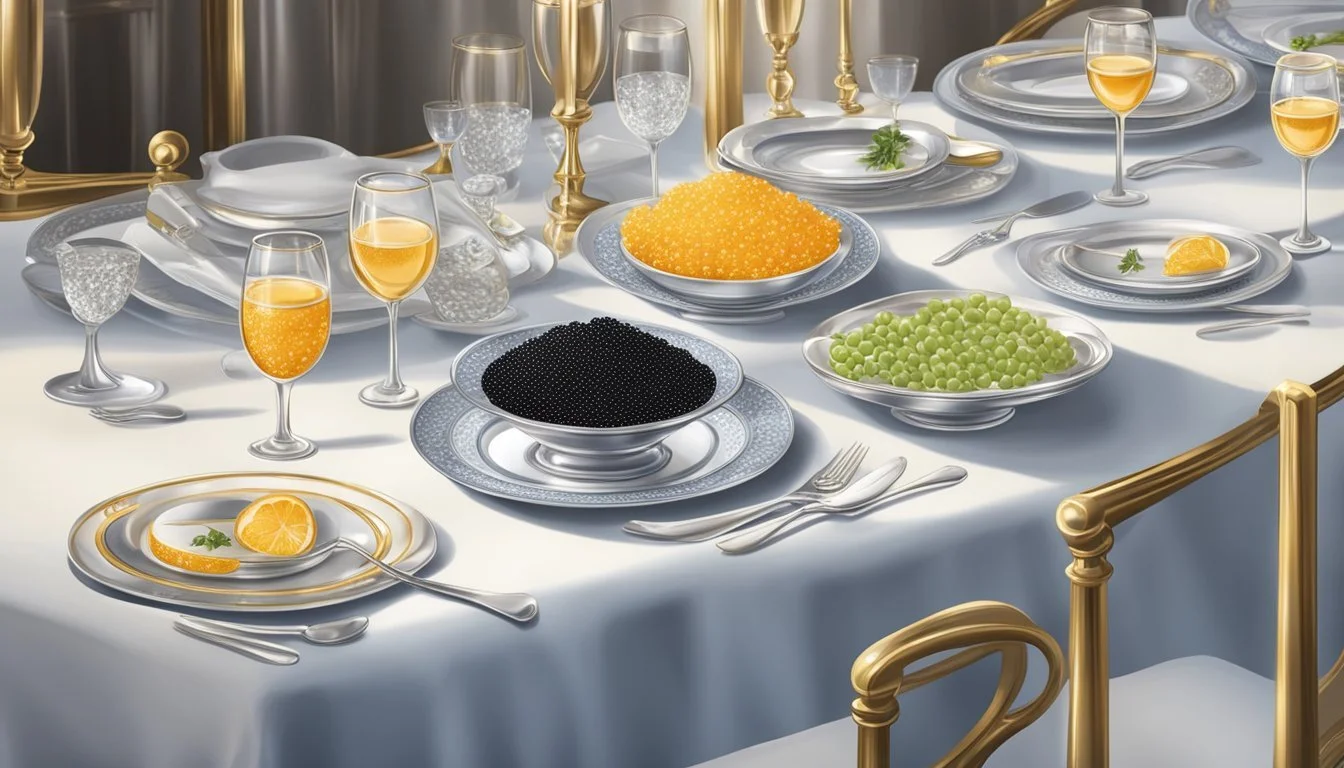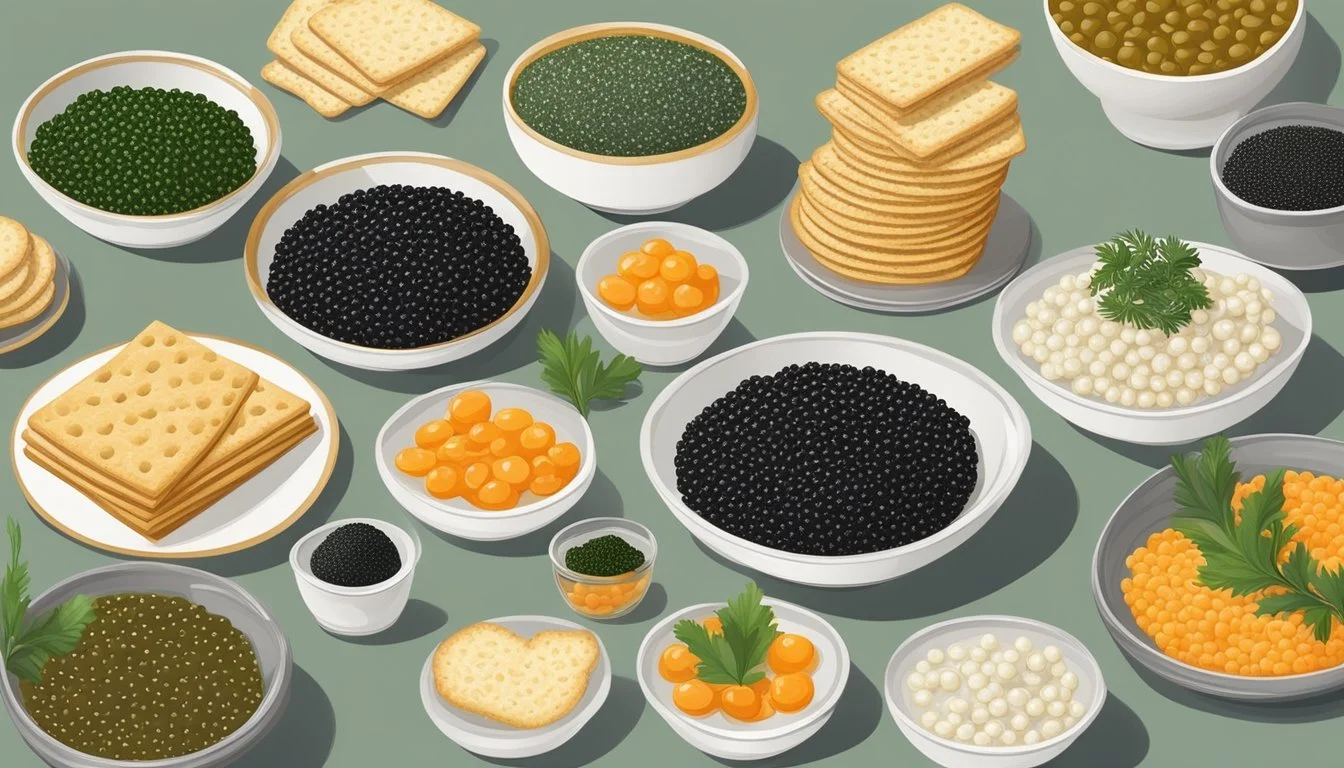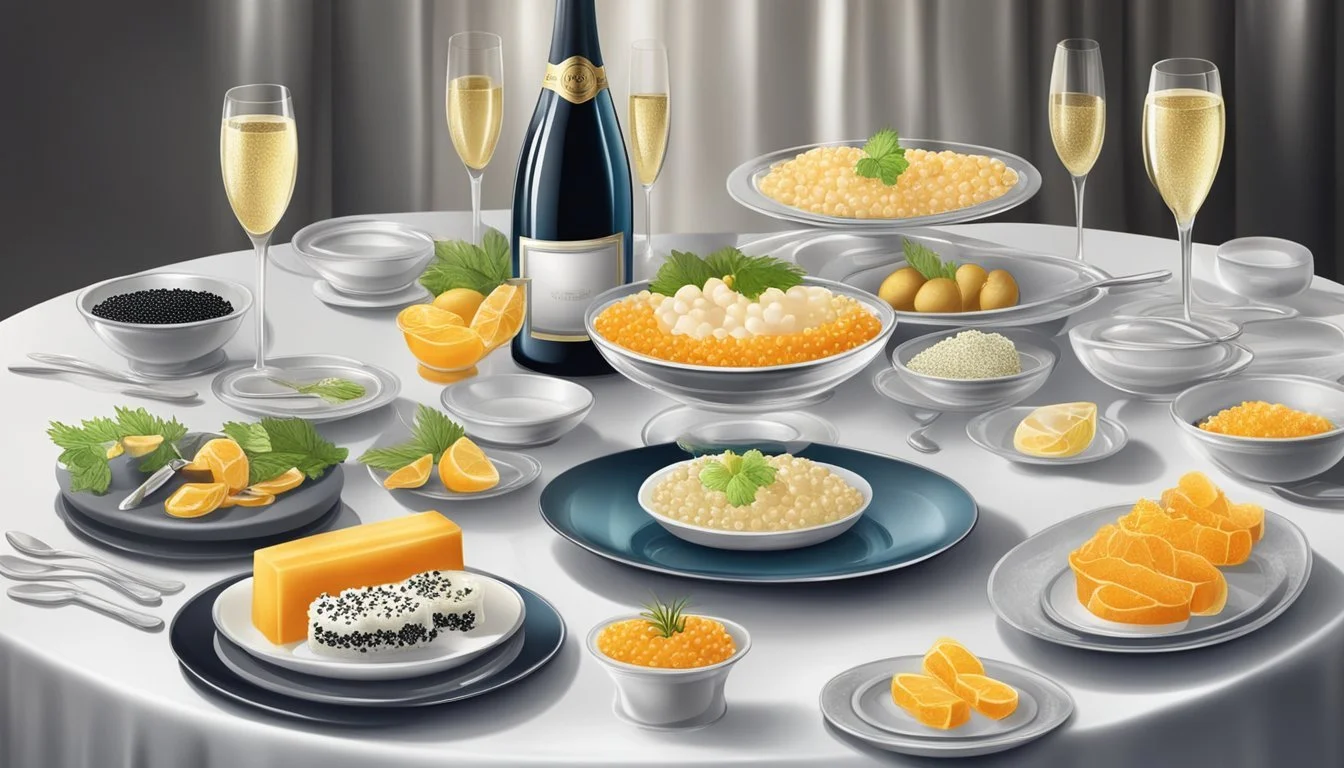Caviar Substitutes
Delicious Alternatives for Every Budget
For many, caviar represents the ultimate luxury in gastronomy. Derived from the roe of sturgeon, it has long been associated with high-end dining and refined taste. However, not everyone can afford or source this exclusive delicacy, and this has spurred interest in caviar substitutes that offer similar flavors and textures without the prohibitive cost.
Various alternatives to traditional caviar have emerged, each bringing a unique twist to the table. Options such as fish roe, soy pearls, and seaweed beads mimic the distinct taste and texture of caviar. Even more inventive substitutes like couscous "faux caviar" highlight the creative potential in gastronomy, offering accessible luxuries without sacrificing flavor.
For those who are keen to explore beyond conventional bounds, herring, salmon, and lumpfish roes serve as excellent stand-ins. These options provide an approachable entry into the world of luxurious taste experiences. By experimenting with these diverse substitutes, one can indulge in high-end culinary pleasures, regardless of budget constraints.
Understanding Caviar
Caviar, a highly prized delicacy, originates from the sturgeon species primarily found in the Caspian and Black Seas. Its history is rich, intertwined with royalty and luxury, and it comes in various types and grades based on quality and flavor.
Definitions and Origins
Caviar refers to the salt-cured roe of sturgeon, primarily from species like Beluga, Sevruga, and Osetra. Authentic caviar is sourced from sturgeon found in the Caspian and Black Sea regions. Beluga caviar is renowned for its large, delicate eggs and buttery flavor. Sevruga has smaller eggs with a crisp texture, while Osetra offers a nutty taste. The authenticity and quality control are paramount to ensure that the caviar meets the high standards expected by consumers.
Historical Significance
Caviar's history dates back centuries, with roots in Russia and Iran. It became synonymous with luxury and was a favored delicacy among Russian royalty and the aristocracy. The advent of sustainable aquaculture has allowed for continued enjoyment of this item without depleting wild sturgeon populations. This shift has also enabled higher quality of caviar by controlling the environment in which sturgeon are raised, ensuring consistency in flavor and texture.
Types and Grading
Caviar is classified by the species of sturgeon and the region of origin. Beluga caviar is the most expensive, noted for its large eggs and smooth flavor. Sevruga and Osetra follow, each offering unique textures and flavors. Beyond sturgeon, alternatives like salmon roe, lumpfish roe, and whitefish roe provide varied experiences. Grading is based on factors like size, color, and appearance of the eggs. Superior grades have larger, uniformly colored eggs with a firm texture and distinct pop when eaten. Grading helps consumers understand the quality control measures, ensuring they receive a product that meets their expectations for a luxury delicacy.
Caviar Production and Sustainability
Caviar production, both from wild sturgeon and aquaculture, affects biodiversity and the environment. Regulations play a crucial role in balancing the trade and conservation of sturgeon populations.
Aquaculture and Wild Sturgeon
Aquaculture has become essential for producing caviar due to the drastic decline in wild sturgeon populations. Overfishing and habitat destruction significantly impact wild sturgeon, making sustainable farming critical.
Sturgeon farming involves controlled environments where fish are bred, raised, and harvested. This method reduces the burden on wild populations and provides a more reliable supply of caviar. Aquaculture can mitigate some environmental concerns, such as overfishing, by offering an alternative to wild-caught caviar.
However, aquaculture isn't without its challenges. Pollution and disease can spread quickly in densely populated fish farms. Proper management and sustainable practices are vital to minimize these impacts and ensure the long-term viability of caviar production.
Regulations and Impact on Biodiversity
Regulations governing caviar production aim to protect wild sturgeon and maintain biodiversity. International agreements, such as the Convention on International Trade in Endangered Species (CITES), regulate sturgeon trade to prevent over-exploitation.
Strict labeling laws are implemented to combat mislabeling and fraud, ensuring consumers can trust the origin and authenticity of the caviar they purchase. These regulations also help conserve wild populations by controlling illegal trade and promoting sustainable practices in aquaculture.
Trade restrictions, combined with conservation efforts, contribute to preserving sturgeon species and their natural habitats. Continuous monitoring and adherence to guidelines are necessary to balance caviar production with biodiversity conservation, ensuring that sturgeon populations remain healthy and ecosystems thrive.
Caviar Alternatives Overview
Exploring alternatives to traditional caviar reveals diverse options suitable for different dietary needs and budgets. These substitutes often maintain the delightful pop, salty flavor, and luxurious essence of caviar yet come from more sustainable or affordable sources.
Culinary Uses and Substitutes
Many culinary experts turn to roe from other fish species as practical substitutes for caviar. Salmon roe, known for its vibrant orange hue and robust flavor, often appears in both fine dining and casual settings. Trout roe offers a similar texture and burst while being more cost-effective.
Lumpfish roe and paddlefish roe serve as other common alternatives. They mimic the appearance and taste of traditional caviar and are frequently used in domestic kitchens and restaurants. American caviar products like whitefish roe are also appreciated for their sustainability and local sourcing.
These products provide a familiar salty taste and satisfying texture but come at a more accessible price point. Such versatility makes them suitable for garnishing dishes or being the star ingredient in gourmet recipes, ensuring the culinary delight remains uncompromised.
Vegetarian and Vegan Options
For vegetarians and vegans seeking a caviar-like experience, innovative alternatives are available. Algae and seaweed caviar produce edible pearls that mimic the texture and briny taste of fish roe. Soy pearls, made through a gelling process involving sodium alginate, also resemble the look and burst of caviar.
These options provide ethical and dietary-friendly solutions without compromising the luxurious experience. Additionally, creations such as couscous "faux caviar" offer a plant-based, affordable alternative that maintains a toothsome bite and can be flavored with ingredients like sepia ink for added authenticity.
These substitutes allow a broader audience to enjoy the elegance typically associated with caviar, ensuring inclusivity in gourmet cuisine.
Popular Caviar Substitutes
There are several substitutes for caviar that vary in terms of taste, texture, and origin. These alternatives include both fish roe-based options and non-fish roe alternatives, catering to a variety of preferences and dietary needs.
Fish Roe Alternatives
Salmon Roe: Known for its larger grains, salmon roe offers a distinct pop and a more pronounced fishy flavor. Often referred to as salmon caviar, it is a popular, less expensive alternative to traditional caviar. It's commonly used in sushi and can also be served on bagels with cream cheese.
Trout Roe: Smaller than salmon roe, trout roe has a delicate texture with a milder flavor. It is typically used in gourmet dishes and garnishes, adding a subtle hint of the sea without overpowering the palate.
Lumpfish Roe: This budget-friendly option comes in bright colors such as red and black. Though the taste is milder and less complex, it serves as a vibrant and visually appealing substitute in hors d'oeuvres and salads.
Paddlefish Roe: Often marketed as American caviar, paddlefish roe is harvested from freshwater paddlefish. It features a robust and buttery taste similar to sturgeon caviar but at a more accessible price point.
Non-Fish Roe Alternatives
Soy Pearls: Soy pearls, also known as vegan caviar, are encased in algae and burst with flavor. These tiny beads emulate the texture of real caviar, making them a great plant-based substitute for those avoiding animal products.
Couscous "Faux Caviar": Prepared by cooking couscous to retain a firm texture and then flavoring it with butter and sepia ink, this inventive alternative offers an affordable and visually convincing substitute suitable for finger foods and appetizers.
Snail Caviar: An unusual substitute, snail caviar comes from farmed snails and has a unique earthy flavor. It has a distinct, slightly crunchy texture and is often sought after for its novelty and gourmet appeal.
Nutritional Comparisons
Caviar substitutes offer various nutritional profiles. Key points include the health benefits and dietary considerations, as well as the importance of freshness and quality.
Health Benefits and Considerations
Caviar substitutes contain different vitamins and minerals depending on their ingredients. For instance, whitefish roe is rich in omega-3 fatty acids, which are beneficial for heart health.
Vegan options, like vegetarian roe made from fruits or vegetables, often provide dietary fiber and vitamins without the cholesterol found in fish roe. Snail caviar is another substitute, offering unique nutrient content and a different lipid profile compared to traditional caviar.
Dietary considerations should also account for allergies and specific dietary restrictions. Vegetarian and vegan caviar options are suitable for those avoiding animal products and can offer essential nutrients found in plant-based diets.
Freshness and Quality
The freshness and quality of caviar substitutes impact both taste and nutritional value. High-quality substitutes should mimic the nutty and buttery flavors of true caviar. Ensuring freshness requires good storage practices, like refrigeration and proper packaging, which preserve nutrient content.
Quality control is crucial, especially for seafood-based substitutes like whitefish roe. Products should be sourced responsibly and monitored to prevent spoilage. Snail caviar, with its unique production process, requires rigorous standards to maintain nutritional value and avoid contamination.
In contrast, vegan options often have a longer shelf life but still demand careful handling to retain their health benefits and textural integrity.
Practical Advice
When selecting caviar substitutes, consider factors such as flavor and texture. Serving and pairing options can elevate the tasting experience, while purchasing tips ensure you get the best quality for your budget.
Selecting and Tasting Substitutes
The flavor and texture of caviar substitutes vary significantly. Salmon roe offers a pronounced fishy taste and a satisfying pop, whereas whitefish roe presents a milder flavor. For those seeking a plant-based option, soy pearls mimic the burst of caviar with a distinct soy sauce essence. Ensuring a substitute's quality involves checking for consistent bead size and a fresh, appealing aroma. Experiment with different types to find a substitute that matches your taste preferences and desired presentation.
Serving and Pairing
Elevate the experience of caviar substitutes by serving them with complementary items. Champagne and vodka are traditional pairings that enhance the flavors of roe. For a different twist, consider pairing with crème fraîche and blinis for a classic presentation. Including vinegar and seaweed in your dishes can add depth and intensity to the flavors. For a buttery note, incorporate small amounts of butter into the accompaniments. These pairings ensure a delightful and sophisticated dining experience, even with cost-effective alternatives.
Purchasing Tips
Quality control is essential when buying caviar substitutes. Look for reputable vendors who provide detailed product descriptions and transparency in their sourcing methods. The price tag can vary, but more expensive doesn't always mean better quality. Affordable alternatives such as paddlefish caviar or even couscous "faux caviar" can offer excellent taste without breaking the bank. Always check reviews and, if possible, purchase small quantities first to ensure the product meets your standards. Remember, authenticity and freshness should be prioritized to enjoy the best possible experience.
Conclusion
Caviar, traditionally made from sturgeon roe, is considered a luxurious delicacy with a unique texture and flavor.
Due to sustainability concerns and the overfishing of wild sturgeon, many seek alternatives.
Caviar substitutes vary widely. Options include fish roe from salmon, trout, and lumpfish, providing a similar salty flavor. American caviar from paddlefish or whitefish offers a domestic, sustainably sourced alternative.
Non-fish options such as snail eggs or couscous "faux caviar" cater to those looking for innovation.
Each substitute aims to replicate the gourmet experience that caviar offers, allowing more people to enjoy this delicacy without compromising on flavor or texture.
The use of various alternatives helps preserve wild sturgeon populations and promotes environmental sustainability. Caviar substitutes continue to evolve, meeting the needs of diverse dietary preferences while still providing a taste of luxury.






